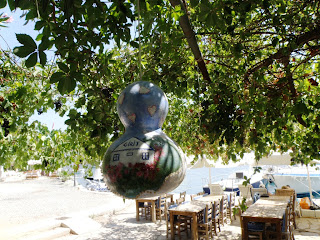 |
| Really wide beach, isn't it! |
 |
| Sardenyu Restaurant, were we first docked |
 |
| BeBe is the boat in the middle. Remember, Bebe's draft is 2.1 meters. That water is deeper than it looks. Amazingly clear! |
Unfortunately, the shore power on this dock was insufficient to operate the air conditioner during the day. It ranged 196v to 208v during the day. But we could run one unit at night when the power draw on the grid was less. So Bill and I slept in the aft cabin bed with Elisabeth sleeping on the settee next to our bed, and Zachary slept in the passageway berth. We closed off the passageway from the main saloon with the curtain and placed a fan at the opposite end of the passageway to suck the cooler air from the aft air conditioner and disperse it into the passageway. This enabled all 4 of us to sleep comfortably.
 |
| Swim area at end of the dock at Sardenyu Restaurant. |
We took the kids to meet the Captain Osman, the 'gold toothed man' we met last year when we visited Selimiye by rental car. He claims he brought all his money with him when he moved from Greece to Turkey years ago -- in the form of gold filling his mouth.
 |
| Captain Osman, the man with the gold teeth; keeps his fortune in his mouth. Serves delicious traditional Turkish casseroles in his sidewalk restaurant on the main harbor shore. |
 |
| Walked around the bay searching for a restaurant recommended by a friend. Missed it while admiring their wine grapes hanging over the walkway. |
 |
| The restaurant we were looking for was Girit. Found it on our way back---beneath the grapes. |
There are places to swim and Zach can kayak when boat traffic isn't active. And plenty of restaurants to enjoy. Even a few small stores to buy basic groceries. And a bakery that bakes the best bread we have found so far in Turkey. No reason to get in a hurry to leave this wonderful place.
 |
| Care to eat lunch seated around a tree? Literally around it. |
Switching to a completely different topic, since the country of Turkey did not come to be until 1922 (previously the Ottoman Empire), I have wondered exactly where the Turkish people originated. After all, even though the country of Turkey did not exist, there are many references to the Turks many hundreds of years prior to the formation of the country named Turkey. Here is a link to a very brief explanation about the origins of the Turkish people:
Origins of Turkish people
 |
| Feeding ducks on our walk around the bay |
According to our Lonely Planet guidebook the Selimiye area is filled with caves and people at one time lived in these caves. Selimiye is situated on the Bozburun peninsula about an hour's drive northwest from Marmaris. This peninsula is the southernmost known boundary of where the ancient Phrygians lived.
The following is taken from the Lonely Planet:
 |
| Elisabeth's Aflak moment |
The Phrygians immigrated from Thrace to central Antolia region around 2000 B.C. They spoke an Indo-European language and used an alphabet similar to Greek. They established a kingdom with its capital well east of here, roughly 60 miles west of Ankara. Their small empire flourished under a successive line of Midas and Gordias kings, until it was overrun by the Cimmerians in the 7th century B.C. The Cimmerians sacked and burned the capital and murdered many Phrygian leaders. Yet the Phrygian culture continued to flourish under the new leaders and subsequent Lydian overtakers.
Considering they lived in rock dwellings, the Phrygians were a sophisticated people with a dedication to the arts. Phrygian culture was based on Greek culture, but with strong neo-Hittite and Urartian influences. They are credited with inventing the frieze, embroidery and numerous musical instruments, including the double clarinet, flute, lyre, syrinx (pan pipes), triangle and cymbals. The Phrygian civilization was at its most vigorous around 585 to 550 B.C. Study of the Phrygians has provided anthropologists with fascinating insights into a culture that bridged the gap between primitive and advanced in central Turkey.


































































